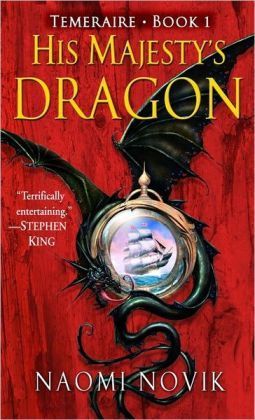I’ve read reviews of His Majesty’s Dragon that describe it as a what-if book. That is, “What if the Napoleonic Wars were fought with dragons?” It does that, but while it’s at it it inadvertently addresses what I think is a much more interesting question: “What if air power had been an important part of European warfare 110 years early?”
The book starts out in a Horatio Hornblower universe and a genre shift creeps up on the reader gradually. William Laurence, British naval captain, captures a French ship with a dragon’s egg on board. Unfortunately, the egg’s about to hatch. Somebody on board must harness the dragon or they risk letting it go feral. The dragon chooses Laurence for a rider and he’s thrust into the Royal Air Corps.
You’ll either love the prose or hate it. The book is deliberately written in the style of novels from the early 1800’s, with long, flowery sentences that’ll leave you wondering where the verb went. I happened to like it. The book is not as stodgy as it sounds (Novik keeps the plot moving along at a modern pace). I was impressed with the technical skill it too for a modern-day American woman to bring us so thoroughly into the head of 1800’s British sea captain, complete with prejudices of the era, and we can still like him.
The plot isn’t remarkable. Laurence and his dragon Temeraire find their way around the Air Corps and eventually get accepted by their new comrades after a climactic battle against Napoleon’s forces. It’s a thin excuse for a guided tour of an R.A.F. with dragons. Novik has thought military strategy with dragons through. You’ll be treated to demonstrations of how air forces assist naval forces, how the government feeds an army of gigantic carnivores, midair safety (carabiners are a big deal), and 3-D midair maneuvers. Read it as alternate history porn and you’ll have a fine old time.
If Novik was going to be really realistic, both England and France would breed the smallest, lightest dragons possible, bomb the other sides’ civilians in the middle of the night, then run like hell. But then the dragons would be sentient airplanes and that wouldn’t be as much fun.
The most annoying moments of the book come when Novik injects twenty-first century sensibilities into the story. Some breeds of dragons will only accept female riders, so women are required to serve in the Air Corps. Laurence has to get over his prejudices and accept his female colleagues. It’s a bit much. Some of the exposition says that women riders have been around since the time of Elizabeth I, so shouldn’t the English people have culturally adapted by then? Perhaps by developing a tradition of shield maidens, like the Vikings did. I would rather have seen female aviators with a defined role in society or seen the book gone for total historical accuracy. As it is, the book is trying to have it both ways and it feels like cheating.
Also, Temeraire the dragon is too damned special. Not only is he the only Chinese dragon in the West, he’s a Celestial, the most special of the Chinese breeds, and he keeps coming up with new abilities that confound his trainers. At the big battle scene at the end he pulls a new superpower out of his ass that saves the day.
On the other hand, it didn’t bother me at all that these behemoths couldn’t possibly fly. It’s magic! Whatever. I thoroughly enjoyed it, but I don’t think I’ll be going for the sequels.

